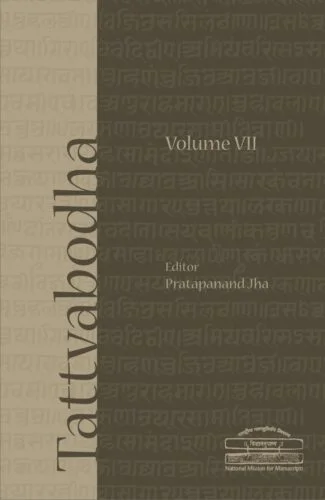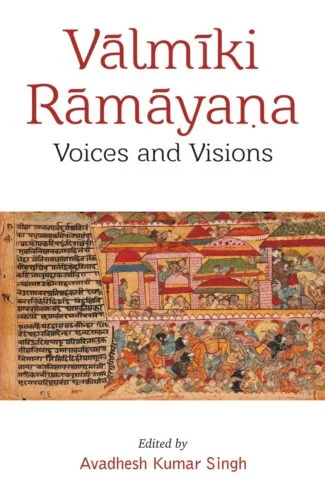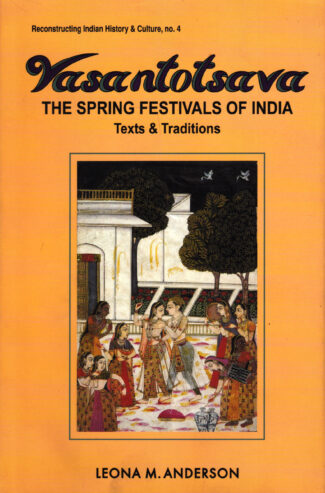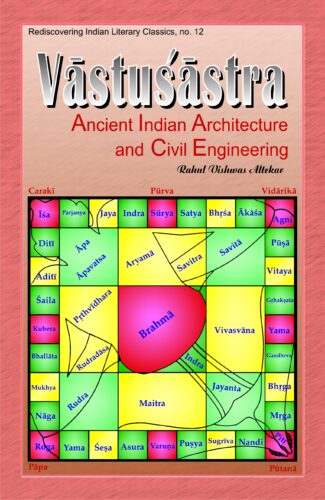Showing 121–132 of 151 results

This volume, seventh in the series, consists of twelve papers eleven in English and one in Hindi presented by scholars of high repute in different Tattvabodha lectures organized by the National Mission for Manuscripts, presenting varied topics across Indian knowledge system.
The National Mission for Manuscripts was established in February 2003 by the Ministry of Culture, Government of India with the purpose of locating, documenting, preserving and disseminating the knowledge content of India’s handwritten manuscripts, said to be the largest collection of handwritten knowledge documents in the world. While looking ahead to reconnect with the knowledge of the past, the Mission is in the process of trying to re-contextualize the knowledge contained in manuscripts for the present and the future generations.
The Mission launched a lecture series titled Tattvabodha in January 2005. Since then, a monthly lecture series is organized in Delhi and other academic centres all over the country. Tattvabodha has established itself as a forum for intellectual discourse, debate and discussion. Eminent scholars representing different aspects of India’s knowledge systems have addressed and interacted with highly receptive audiences over the course of the past few years.
This volume, seventh in the series, consists of twelve papers Þ eleven in English and one in Hindi presented by well-known and upcoming scholars in different Tattvabodha lectures organized by the Mission.
The volume finds its merit in varied subjects across Indian knowledge system such as Accessing Manuscripts in the Digital Age; Physics in Ancient Indian Knowledge System; Critical and Comparative Review of the Principal Upanishads; The Concept of Shiva in Shiva-rahasya; The Ramacaritam of Ciraman; Editing of Ayurvedic Manuscripts; The Dravyanamakara Nighantu; Tribal Heritage and Indigenous Philosophical Wisdom of Odisha; Glimpses of Archival Manuscripts; Gandhari: A Key Mother Figure of the Mahabharata; Depiction of Indian Culture in Sanskrit Inscriptions of Cambodia; Phasi Katha-Parampara aura Arabyayamini.
The introductions, interpretations, explanations and analyses involved herein should solicit keen interest among academicians, scholars and students of Indology.

In this volume the first English-language publication on the subject the author describes the various indigenous musical instruments which support rituals and performances within and outside the temples of Kerala. Illustrations of each instrument, accompany the text, with information on its dimensions, construction, playing techniques, methods of training and music.
The performing arts of Kerala Kathakali, Kutiyattam, Mohiniattam, and other forms of dance and drama occupy a vital space in Indias creative imagination. All these performances move to a music that is supported by Keralas indigenous musical instruments a variety of drums and clappers, as well as a smaller number of pipes and strings.
Quite a few of these instruments are also found associated with rituals and festivities in the temples of Kerala: the Itakka, Chenta, Timila, Milavu, Suddha Maddalam all membranophones; the aerophones Kurum Kulal and Kompu Vadyam; and Ilattalam, an idiophone. Notes on these instruments by a devoted student of the performing arts of Kerala are put together in this small volume the first English-language publication on the subject. Illustrations of each instrument accompany the texts.
The author brings to his task the benefit of an intimate knowledge of each instrument, acquired through years of fieldwork, as well as an erudition born of his immersion in literary classics in Tamil, Malayalam and Sanskrit. The pieces here are a source too of the folklore associated with Keralas musical instruments. The chief strength of the book, however, lies in the precise information it provides on each instrument its dimensions, materials, construction, playing techniques, methods of training, and, not least, its music.
Apart from musicians and musicologists, this book would interest students of Keralas folklore and anthropology, as well as general readers with a special interest in the arts and culture of Kerala.

The Journey of Advaita elucidates the richness, depth and profundity of Advaitic thought right from the Vedas to the Integral Advaitism of Sri Aurobindo, and further how it is being incorporated in modern science. In its long journey, it found its blossom in Shankaras Kevaladvaita, and in its further growth, Bhakti-Vedanta played an important role through Ramanuja, Madhva, Nimbarka and Vallabha.
The Journey of Advaita elucidates the richness, depth and profundity of Advaitic thought right from Vedas to Integral Advaitism of Sri Aurobindo and further how it is being incorporated in modern science.
Advaita Philosophy is not a later development of thought as one of the six systems of Indian philosophy. Vedas are replete with suggestions about Unity. The earlier stage of naturalistic and anthropomorphic polytheism yielded to monistic belief. In the dictum, ekam sad vipra bahudha vadanti we perceive an echo of Unity. Upanishadic seers picked up this Unity and tirelessly went in their search till they came to the highest conclusion, tat tvam asi.
This concept of Unity gets its full bloom in Shankaras Kevaladvaita; later on it gave inspiration to different rivulets of Vedanta schools. Shankaras unqualified impersonal Brahman could not satisfy those who sought loving communion with God. Consequently different schools of Bhakti-Vedanta came into existence, namely, Vishishtadvaita of Ramanuja, Dvaita of Madhva, Dvaitadvaita of Nimbarka and Shuddhadvaita of Vallabha. For all of them the emphasis is on the liberation of individual soul only, which gave way to Sri Aurobindos Integral Advaitism where the emphasis is not only on spiritualization of man but of the whole cosmos.
The journey continues further with modern physics. Consciousness is the building block of the Universe and the ground of all beings, which cant be found in plural.

It shows how reality is generated in a recursive fashion and uses this insight to illuminate many puzzles of history and culture. The book straddles history and science, aesthetics and religion, and politics and power, by juxtaposing material in ways that provide surprising new insights.
The Loom of Time shows how reality is generated in a recursive fashion and uses this insight to illuminate many puzzles of history and culture. Recursion is at basis of mimicry in nature and germination and development of biological organisms; it also provides structure to mental images of physical systems and human behavior. It helps us make sense of the repeating patterns across cultures and nations, understand the manner in which technology is impacting society, and see the reasons behind the crises of the contemporary world.
The topics covered in this book include philosophical bases of recursion, cosmologies old and new, religion and modernity, globalization and bureaucratic control, loss of meaning and freedom, spirituality, narcissism leading to despair, and limits of medicine. It deals with problems of employment and questions of meaning of life when robots and other machines become more numerous than humans. The book straddles history and science, aesthetics and religion, and politics and power, by juxtaposing material in ways that provide surprising new insights.

The book presents the notion of unity in diversity in the context of globalization and multiculturalism. The concepts of unity and diversity have been contested in classical and modern theories. These theories give rise to the concept of diversity but jointly somehow they emerge as unity in diversity.
The book presents the notion of unity in diversity in the context of globalization and multiculturalism. Philosophically speaking, the concepts of unity and diversity have been contested in classical and modern theories; for instance, Plato’s idea of harmony and goodness, Aristotle’s phronesis or practical wisdom (teleology), Kant’s categorical imperative (deontology), and Mill’s utilitarianism (consequentialism) on the one hand and purusarthas divided into abhyudaya and nihsreyas, etc. on the other. These theories give rise to the concept of diversity but jointly somehow they emerge as unity in diversity.
In the era of globalization and multiculturalism, teleology, deontology, consequentialism and so on have been described, critiqued and even appreciated and appropriated from pluralistic perspective. With globalization and multiculturalism, human life is affected not only insofar as market is concerned, but also the ethnical, cultural and linguistic identities are equally affected. However, unlike globalization, multiculturalism endorses the role of the State in protecting and safeguarding the rights of diverse cultural groups, values and practices, marriage and settlements, property and inheritance, etc. so that members of each cultural community should become the valid participants in the civil and democratic life in the globalized world.
The perspectives of, and the conflict between individual needs and rights, and group needs and rights, have been conceptualized under liberalism and communitarianism. It is proposed to be achieved by developing cultural transformations in the era of globalization, thus creating reasonable exclusion on broader values. The effort is to allow these values to inform and reinforce each other for the possible foundations of multiculturalism, specially cosmopolitanism in the globalized world.

An anthology of over 90 articles penned by the renowned Sanskritists and Indologists in order to felicitate Prof. Vachaspati Upadhyaya covers different domains of Indian intellectual tradition, emphasizing upon the dialectical depth and thematic width of Indian philosophy, religions and culture enshrined in Sanskrit sources.
Vacaspativaibhavam is a modest tribute to the dynamic persona of Professor Vachaspati Upadhyaya whose chequered career spans more than four decades. In this volume, an earnest endeavour is made to collect and recollect his significant contribution to the academic world, both as a scholar as well as an administrator.
The first part of this volume carries benign blessings of saints and scholars for the unbound showering of divine grace upon Professor Upadhyaya. Many messages by the dignitaries and copious compliments from well-wishers and friends of Professor Upadhyaya convey his unmitigated commitment to the core human values cherished in his heart.
The second section of the volume comprises rich reminiscences penned by a vast majority of his colleagues and students from all over the country. These memoirs, in the form of personal reflections, are richly expressed through the medium of poetry and prose, and reveal the various aspects of the multifaceted personality of Professor Vachaspati Upadhyaya.
More than ninety research papers included in the principal part of the volume are not limited to the narrow compartmentalization of a particular subject but cover different domains of Indian intellectual tradition. Authored by a galaxy of scholars, Indian and foreign, these articles not only highlight the new ventures in cross-disciplinary studies, but also emphasize their basic concern with contemporary challenges facing humanity. The readers will relish that contributors to the volume have effectively reflected upon the dialectical depth and thematic width of Indian philosophy, religion and culture enshrined in Sanskrit sources.
In fine, the volume in hand promises to provide meaningful material for thought in the fields of Sanskrit and Indological Studies.
Vada, meaning debates, dialogues, discussions, was the quintessential of Indian spirit, enabling and promoting the growth of different philosophical and knowledge systems of India. It percolated deep into our mindset and enriched the moral, ethical, religious and sociocultural edifice of anything that was essentially Indian in nature. As continuation of Anvikshiki from the bc era, vada helped thrive Indian traditional knowledge systems. It subsists on diversity and its tradition envisages pluralism.
Most of our Sanskrit works, covering a wide gamut of knowledge systems, are structured in the techniques of debate. This reality applies not only to the philosophical writings, but to Indian medical systems (Ayurveda), Arthashastra of Kautilya and Kamasutra of Vatsyayana as well. Even great epics like Ramayana and Mahabharata are no exceptions.
Vada culture involved verbal duals, attacks and even violence of speech, and all major religious systems — old or modern — were parties to it. This book also elucidates how vata was vital and critical for the growth of our socio-political fabrics. It shows how some of the major conflicts in philosophical systems were centred around karma, jnana, choice between violence and non-violence, pravritti and nivritti. It also presents the manifestations of vada on a vast canvas during the nineteenth and twentieth centuries. Modern spiritual and religious gurus like Ramana Maharshi, J. Krishnamurti and Vinoba Bhave were men of dialogues. Our scholars have applied the varied techniques of vada against the philosophical and scientific systems of the West to prove them correct.
This collector’s issue should enthrall a wide audience of philosophers, scholars and believers in Indian knowledge systems.

This book reconsiders Valmiki Ramayana from different perspectives literary, aesthetic, ethical, comparative, interdisciplinary, religious, philosophical, social, and archaeological among others. In the process, it underscores significance of Ramayana from modern perspective, as it unveils its multilayered worlds.
Valmiki Ramayana, the first kavya (poetic composition) and the first mahakavya (epic) of the world, is an inexhaustible fountain of culture and knowledge. It has impacted infinite minds and souls in India and abroad, and continues to inspire and engage creative and critical minds, and will remain so for the ages to come.
Ramayana, along with standardizing Ramakatha, transcends history, geography and binaries of mode of thinking. Its appeal may be discerned from the fact that it exists in different versions in various regions and forms. Notwithstanding these versions, Valmiki Ramayana rules human heart and mind for its subject matter and manner of articulation.
The multilayered worlds of Ramayana make it a seedbed of ideas existing at various levels. Traversing generations, and getting interpreted anew in consonance with cultural needs and existential questions, it has earned serious critical consideration of scholars from different perspectives literary, aesthetic, ethical, comparative, interdisciplinary, religious, philosophical, moral, social, archaeological, and intermedial among many. Hence, it demands its reinterpretation by every generation. The present book is a testimony to it, and a response in this direction.
Consisting of scholarly papers by eminent intellectuals and with a perspicuous introduction, this book reconsiders Valmiki Ramayana from different perspectives, presented in a seminar on Ramayana that was organized with the blessings of Pujya Morari Bapu.

This volume, through colours, transcends many a cue of the aesthetic aspects of human life into a connoisseur’s mind. Whether on fabric or canvas, mud wall or floor, sculptures or pots, colours for us is a language, a raga and a tala.
Colours are not just for adornment, but a medium that reflects our state of mind, artistic acumen, culture, ethics, philosophy, social values, tradition and the sacredness of life. A non-verbal language, they conjure up our emotions, feelings and moo ds, and take a rasika far beyond the realms of words. In them we see the lush and luxuriant natural world around us, the world of birds and blossoms, earth and sky, gems and stones, creating in us a certain feeling and a gush of powerful ethos.
The artist in Varsha, through colours, transcends many a cue of the aesthetic aspects of human life into a connoisseurs mind. Whether on fabric or canvas, mud wall or floor, sculptures or pots, colours for us is a language, a raga and a tala. And Celebration of Colours is just that.
Involved with her family, Varsha loves art and craft, whether it is painting, embroidery, working with terracotta and ceramic, jewels and the creation of ornaments, crochet and knitting, stitching and designing clothes, or cooking. Absorbed in the world of colour, she likes to share her moment of beauty with everyone around her and spread joy everywhere.

This study treats Vasantotsava as a thematically unified generic whole embracing a range of spring festivals, pansectarian in character and incorporating various rituals. It reassesses Sanskrit texts to explore the rituals, symbols and underlying motifs of the Vasantotsava.
This study treats Vasantotsava as a thematically unified generic whole embracing a wide range of spring festivals including the Phalgunotsava, Caitrotsava, Phalgu, Madhutsava, Madanamahotsava, Madanatroydashi, Anangotsava, Madanadvadaishi, Kamotsava, Shripancami, Yatramahotsava, and Holaka (Holi). These festivals are pansectarian in character and incorporate a variety of ritual observances practised through- out the Indian subcontinent. Signifying the termination of winter and announcing the advent of spring, the celebration was a diverse and complex spectacle situated within the framework of Indian ritual and myth. On the basis of puranic and ritual texts, folk tales, drama, poetry, and narratives in mixed prose and poetry (campus), Dr. Anderson addresses complex issues of indigenous ritual, mythology, and tradition. The Vasantotsava incorporates a broad spectrum of human concerns: in the sphere of polity, it can be turned to account to celebrate and reinforce the power of the king; in the social sphere, it is a time of revelry and merry-making indicative of the annual renewal in human affairs; and in the sphere of religion, it celebrates the exploits of the gods and establishes a link between human and divine actions and events.

Examining vàstu÷àstra’s conceptual roots in øilpa÷àstra and its later evolution, the volume analyses technical aspects of vàstu÷àstra by concentrating on the essential elements (aïgas) of vàstu÷àstra which involve decision-making and actual construction methods, art of engineering and role and responsibilities of engineers, and aspects related to land materials and rituals associated with use of building after its construction
Though there has been considerable interest in vastushastra in recent times and the orientational aspects of vastushastra have been often discussed, little is known of the essential elements that constitute This small book, written in a simple and lucid style, contains teachings of great men, gleanings from the scriptures, and examples from the epics and Puranas, and suggests easy solutions to the various problems faced by man in the present-day world of violence, wars, killings and disasters, and how to have a holistic approach to life vastushastra and its scientific application in the present day. Based on extensive research, the work, vastushastra attempts to address this aspect. Examining comprehensively the subject of vastushastra: its conceptual roots in Shilpashastra and its later evolution as dealt with in the Vedas, the Epic literature, Arthashastra, literature on ayurveda and Kamasutra literature, the volume analyses technical aspects of vastushastra by concentrating on the essential elements [angas] of vastushastra which involve decision-making and actual construction methods, art of engineering and role and responsibilities of engineers, and aspects related to land materials and rituals associated with use of building after its construction. It discusses the eco-friendly life style of the ancient Indians based on vastushastra principles. Giving minute attention to details, it focuses on the application of vastushastra in the present-day society — how the vastushastra principles can be scientifically applied and the potential of application of vastushastra keeping in view modern trends in architectural science and civil engineering.
The book will be useful for students and scholars of architecture and engineering and those interested in vastushastra.

Examining vàstu÷àstra’s conceptual roots in øilpa÷àstra and its later evolution, the volume analyses technical aspects of vàstu÷àstra by concentrating on the essential elements (aïgas) of vàstu÷àstra which involve decision-making and actual construction methods, art of engineering and role and responsibilities of engineers, and aspects related to land materials and rituals associated with use of building after its construction
Though there has been considerable interest in vastushastra in recent times and the orientational aspects of vastushastra have been often discussed, little is known of the essential elements that constitute This small book, written in a simple and lucid style, contains teachings of great men, gleanings from the scriptures, and examples from the epics and Puranas, and suggests easy solutions to the various problems faced by man in the present-day world of violence, wars, killings and disasters, and how to have a holistic approach to life vastushastra and its scientific application in the present day. Based on extensive research, the work, vastushastra attempts to address this aspect. Examining comprehensively the subject of vastushastra: its conceptual roots in Shilpashastra and its later evolution as dealt with in the Vedas, the Epic literature, Arthashastra, literature on ayurveda and Kamasutra literature, the volume analyses technical aspects of vastushastra by concentrating on the essential elements [angas] of vastushastra which involve decision-making and actual construction methods, art of engineering and role and responsibilities of engineers, and aspects related to land materials and rituals associated with use of building after its construction. It discusses the eco-friendly life style of the ancient Indians based on vastushastra principles. Giving minute attention to details, it focuses on the application of vastushastra in the present-day society — how the vastushastra principles can be scientifically applied and the potential of application of vastushastra keeping in view modern trends in architectural science and civil engineering.
The book will be useful for students and scholars of architecture and engineering and those interested in vastushastra.
| There are no products |